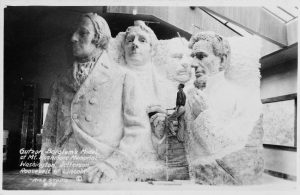Mt. Rushmore is situated in the Black Hills of South Dakota. The Black Hills were originally promised to the Lakota Native Americans in the Treaty of Fort Laramie in 1868, but in the 1870s, the federal government reclaimed ownership (Taliaferro 24, 34). In 1932, State Historian Doane Robinson came up with the idea of carving the mountains to attract tourists to South Dakota. Originally, Robinson wanted to carve historic figures representing a romantic view of the west, including Native American icons, but when the the artist, Gutzon Borglum, joined the project, the focus turned to a nationalistic view (Glass 156). The presidents were chosen for their work as imperialists, expanding the nation (Glass 158). Mt. Rushmore was carved during the Great Depression, from 1927 to 1941, and cost about $1 million (Bergman 147). Borglum had envisioned a grander monument, including the presidents down to the waist and a timeline of their achievements, but the project ended after the heads were complete (Bergman 148).

For the Lakota people, this was seen as the theft and desecration of land that they were promised by the government. Many naturalists and the Lakota people believe that any monument carved into or placed by the Black Hills is disrespectful, regardless of who is depicted (Taliaferro 61). “The Black Hills” is a translation of the Lakota name for the mountains, and they believe that the Black Hills are a sacred space. They use the mountains as a retreat of sorts where they can “fast, pray, and worship Wakan Tankan or the Great Mystery, the essence of Lakota spiritual and religious life” (Hanson and Chirinos 13). In 1980, the Lakota people won a lawsuit arguing that the Black Hills had been illegally taken from them by the United States. They have won hundreds of millions of dollars from this legal action, but have refused to accept the money (Bergman 153).
Nowadays, a few million people visit the site each year (Bergman 145). Mt. Rushmore was the eighth most visited National Memorial in 2015, making it a must for people touring patriotic sites around the nation (United States National Park Service, “Stats”). The concept of visiting these National Parks, Monuments and Memorials ties into the practice of civil religion. Civil religion can take on many different definitions, but in this context it refers to American symbols being given a religious meaning. When people devote their time to these national sites they are participating in a culture of viewing places of national importance in a spiritual manner. Because competing views of this section of the Black Hills exist, it is a difficult site to properly maintain. The National Park Service frequently cites their need for better informational material at the Monument (Bergman 150).
-Kate Houghtaling, December 2016
Suggestions for Further Reading:
- Bergman, Teresa. Exhibiting Patriotism: Creating and Contesting Interpretations of American Historic Sites. Walnut Creek, US: Routledge, 2016.
- Glass, Matthew. “Alexanders All: Symbols of Conquest and Resistance at Mount Rushmore.” In American Sacred Space, ed. David Chidester and Edward T. Linenthal, 152-182. Bloomington: Indiana University Press, 1995.
- Hanson, Jeffery R., and Sally Chirinos. Ethnographic Overview and Assessment of Devils Tower National Monument, Wyoming. Denver, Colo.: U.S. Department of the Interior, National Park Service, Intermountain Region, 1997.
- Taliaferro, John. Great White Fathers: The Story of the Obsessive Quest to Create Mount Rushmore. New York: Perseus Books Group, 2002.
-
United States National Park Service. “Stats Report Viewer.” National Parks Service Website. Accessed December 06, 2016. https://irma.nps.gov/Stats/SSRSReports/National Reports/Annual Park Ranking Report%20(1979%20-%20Last%20Calendar%20Year).
Featured Image: Mt Rushmore before the rain by Ghorseman. Used according to the terms of the Creative Commons License.
Image 1: Gutzon Borglum’s model of Mt. Rushmore memorial. Public domain.
